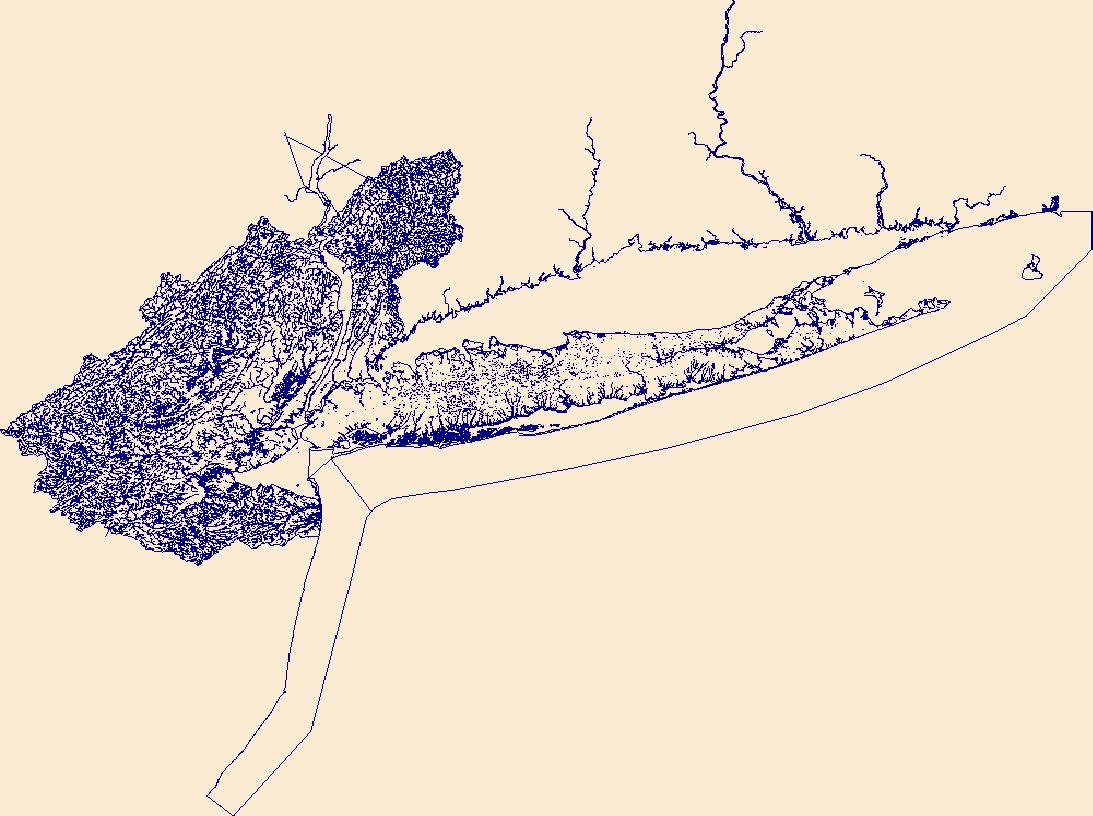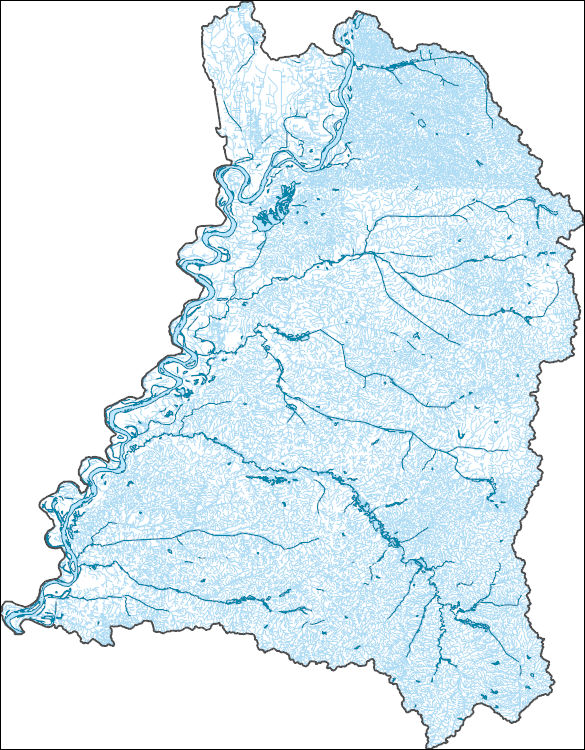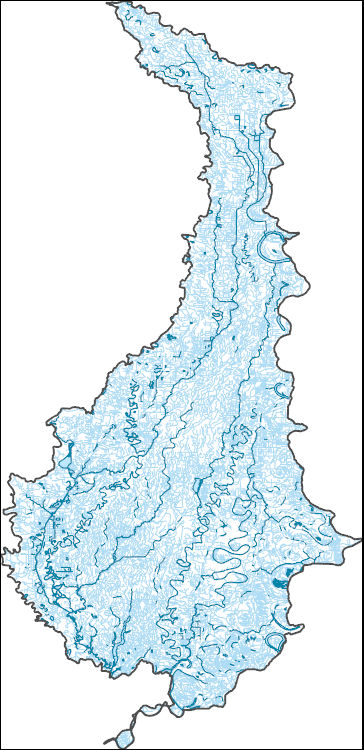Filters: Tags: geospatial analysis (X)
808 results (62ms)|
Filters
Date Range
Extensions Types Contacts
Categories
Tag Types
|
Well-established conservation planning principles and techniques framed by geodesign were used to assess the restorability of areas that historically supported coastal wetlands along the U.S. shore of western Lake Erie. The resulting analysis supported planning efforts to identify, prioritize, and track wetland restoration opportunity and investment in the region. To accomplish this, publicly available data, criteria derived from the regional managers and local stakeholders, and geospatial analysis were used to form an ecological model for spatial prioritization (Western Lake Erie Restoration Assessmente (WLERA)). Within the 192,618 ha study area that was bounded by the mouths of the Detroit River, MI to the north...
This dataset is the output of a python script/ArcGIS model that identifes dikes as having a difference in elevation above a certain threshold. If the elevation difference was below a certain threshold the area was not considered a dike; however, if the difference in elevation between two points was significantly high then the area was marked as a dike. Areas continuous with eachother were considered part of the same dike. Post processing occured. Users examined the data output, comparing the proposed dike locations to aerial imagery, flowline data, and the DEM. Dikes that appeared to be false positives were deleted from the data set.
Categories: Data;
Types: Citation,
Downloadable,
Map Service,
OGC WFS Layer,
OGC WMS Layer,
Shapefile;
Tags: Great Lakes,
LIDAR,
Saginaw Bay,
biogeography,
coastal ecosystems,
This represents the flowline network in Sagina Bay Restoration Assessment (SBRA). It is attributed with the number of disconnections between the reach and the connecting river system. These data will help identify the condition of hydrologic separation between potential restoration areas and the connecting river system. Low numbers represent fewer disconnections such as culverts between the reach and the rivers requiring no flow network modification to restore the area.
Categories: Data;
Types: Citation,
Downloadable,
Map Service,
OGC WFS Layer,
OGC WMS Layer,
Shapefile;
Tags: Artificial Path,
Canal / Ditch,
FWHydrography,
Great Lakes,
Hydrography,
Empirical evidence that local adaptation and home-site advantages are frequent across plant taxa has increased recognition that local adaptation plays a fundamental role in shaping plant responses to seed transfer (i.e., when plant materials are introduced to a site during restoration). Use of maladapted plant materials can lead to poor project outcomes if propagules exhibit poor germination or seedling survival, low population fitness, inbreeding or outbreeding depression. Accounting for local adaptation in restoration designs is a promising approach for increasing revegetation effectiveness, particularly in drylands where extreme environmental variation potentially drives high levels of selection. Consequently,...
This part of DS 781 presents data for the bathymetric contours for the Offshore of Aptos map area, California. The vector data file is included in "Contours_OffshoreAptos.zip," which is accessible from https://doi.org/10.5066/F7K35RQB. These data accompany the pamphlet and map sheets of Cochrane, G.R., Johnson, S.Y., Dartnell, P., Greene, H.G., Erdey, M.D, Dieter, B.E., Golden, N.E., Hartwell, S.R., Ritchie, A.C., Kvitek, r.G., Maier, K.L., Endris, C.A., Davenport, C.W., Watt, J.T., Sliter, R.W., Finlayson, D.P., and Krigsman, L.M., (G.R. Cochrane and S.A. Cochran, eds.), 2016, California State Waters Map Series—Offshore of Aptos, California: U.S. Geological Survey Open-File Report 2016–1025, 43 p., 10 sheets, scale...
Categories: Data;
Types: Downloadable,
Map Service,
OGC WFS Layer,
OGC WMS Layer,
Shapefile;
Tags: Aptos,
CMHRP,
Coastal and Marine Hazards and Resources Program,
Continental/Island Shelf,
Fisheries,
From May 2017 to November 2019, the U.S. Geological Survey conducted bathymetric surveys of New York City's East of Hudson Reservoirs. Bathymetry data were collected at East Branch Reservoir May 2018, June 2018, and October 2019. Depth data were collected primarily with a multibeam echosounder; additional bathymetry points were measured using an acoustic Doppler current profiler (ADCP). Quality assurance points were measured with a single-beam echosounder. Water surface elevations were established using real-time kinematic (RTK) and static global navigation satellite system (GNSS) surveys and submersible pressure transducers. Measured sound velocity profiles were used to correct echosounder depth measurements...
Categories: Data;
Types: Downloadable,
GeoTIFF,
Map Service,
OGC WFS Layer,
OGC WMS Layer,
Raster,
Shapefile;
Tags: Ambient Monitoring,
Basin & Hydrogeologic Characterization,
East Branch Reservoir,
New York,
Putnam County,
In 2013, the first of several Regional Stream Quality Assessments (RSQA) was done in the Midwest United States. The Midwest Stream Quality Assessment (MSQA) was a collaborative study by the U.S. Geological Survey (USGS) National Water Quality Assessment (NAWQA), the USGS Columbia Environmental Research Center, and the U.S. Environmental Protection Agency (USEPA) National Rivers and Streams Assessment (NRSA). One of the objectives of the RSQA, and thus the MSQA, is to characterize the relationships between water-quality stressors and stream ecology and to determine the relative effects of these stressors on aquatic biota within the streams (U.S. Geological Survey, 2012). To meet this objective, a framework of fundamental...
Categories: Data;
Types: Citation,
Downloadable,
Map Service,
OGC WFS Layer,
OGC WMS Layer,
Shapefile;
Tags: Geographic Information Systems,
Geospatial Analysis,
Geospatial Datasets,
Illinois,
Indiana,
This section of the data release includes tables in the format of comma-separated value (CSV) files with elevation-area-volume relationships for Great Salt Lake. The volume and area of Great Salt Lake were calculated from the topobathymetric raster dataset, which was resampled from 0.5-meter to 5.0-meter resolution, at elevation increments of 0.01 feet between 4,170.00–4,215.00 ft above the North American Vertical Datum of 1988. Data are provided as total values for Great Salt Lake as well as regional values for the north arm, south arm, Bear River Bay, and Farmington Bay.
Kootenai river hydraulic conditions were simulated using the iRIC FaSTMECH two-dimensional hydraulic flow model (Nelson, 2003). In addition to this study, FaSTMECH 2D flow models have been developed for numerous Kootenai River studies dating back to 2005. The methods used to develop, calibrate, and simulate FaSTMECH 2D flow models are described at length in multiple previous studies (Fosness and Dudunake, in press; Barton and others, 2005; Barton and others, 2007; Logan and others, 2011; McDonald and others, 2016; McDonald and Nelson, 2018; McDonald and Nelson, 2020). Model simulations were combined with white sturgeon telemetry data to explain fish positions with respect to selected depths and depth-averaged velocity.
Categories: Data;
Types: Map Service,
OGC WFS Layer,
OGC WMS Layer,
OGC WMS Service;
Tags: Aquatic Biology,
Bonners Ferry,
Boundary,
Ecology,
Idaho,
Digital flood-inundation maps for a 3.4-mile reach of Fourmile Creek at Silver Grove, Kentucky (Ky.), were created by the U.S. Geological Survey (USGS) in cooperation with the City of Silver Grove and the U.S. Army Corps of Engineers Louisville District. Because the City of Silver Grove is subject to flooding from Fourmile Creek and the Ohio River (backwater flooding up Fourmile Creek), a set of flood-inundation maps was created for each flooding source independently and for combinations of possible flooding scenarios. The flood-inundation maps depict estimates of the areal extent and depth of flooding corresponding to a range of different gage heights (gage height is commonly referred to as “stage,” or the water-surface...

This feature class represents inundated area for the Coast Fork of the Willamette River, the Row River and Silk Creek (west of Cottage Grove, OR) for eight different flows at the gage Willamette River at Goshen, OR (USGS 14157500). The flows are 12,000; 15,000; 21,450; 27,900; 33,900; 39,900; 46,800 and 62,300 cubic feet per second (cfs). These flows correspond to gage heights of 11.8, 13.2, 15.1, 16.3, 17.2, 17.9, 18.6 and 19.8 feet, respectively. The domain of the model is as follows: Row River from Dorena dam to the confluence with the Coast Fork; Coast Fork from Cottage Grove dam to the confluence with the Middle Fork; Silk Creek from River Mile 1.7 to the confluence with the Coast Fork. The basis for these...

The domain of the model is as follows: Row River from Dorena dam to the confluence with the Coast Fork; Coast Fork from Cottage Grove dam to the confluence with the Middle Fork; Silk Creek from River Mile 1.7 to the confluence with the Coast Fork. The basis for these features is the Willamette Flood Insurance Study – Phase One (2013). The hydraulics and hydrology for the FIS were reused in the production of these polygons; the reports and information associated with the FIS are applicable to this product. The Digital Elevation Model (DEM) utilized for the Willamette FIS submittal was produced by combining multiple overlapping topographic surveys for the Middle Fork and Coast Fork of the Willamette River. This DEM...

The High Resolution National Hydrography Dataset Plus (NHDPlus HR) is an integrated set of geospatial data layers, including the National Hydrography Dataset (NHD), National Watershed Boundary Dataset (WBD), and 3D Elevation Program Digital Elevation Model (3DEP DEM). The NHDPlus HR combines the NHD, 3DEP DEMs, and WBD to a data suite that includes the NHD stream network with linear referencing functionality, the WBD hydrologic units, elevation-derived catchment areas for each stream segment, "value added attributes" (VAAs), and other features that enhance hydrologic data analysis and routing.
Five principal components are used to represent the climate variation in an original set of 12 climate variables reflecting precipitation and temperature gradients. The dataset provides coverage for four regions (the Sonoran Desert, Mojave Desert, Colorado Plateau, and Southern Great Basin) and three time periods including current climate (defined as the 1980-2010 normal period) and future climate (2010-2040 and 2040-2070 normal periods) under the RCP4.5 and RCP8.5 emission scenarios. Climate variables were chosen based on their known influence on local adaptation in plants, and include: mean annual temperature, summer maximum temperature, winter minimum temperature, annual temperature range, temperature seasonality...
Categories: Data Release - Revised;
Tags: Arizona,
California,
Colorado,
Colorado Plateau,
Great Basin,
This child item data set contains the hydraulic model used for flood-inundation maps for the Schoharie Creek in North Blenheim, New York.

The High Resolution National Hydrography Dataset Plus (NHDPlus HR) is an integrated set of geospatial data layers, including the best available National Hydrography Dataset (NHD), the 10-meter 3D Elevation Program Digital Elevation Model (3DEP DEM), and the National Watershed Boundary Dataset (WBD). The NHDPlus HR combines the NHD, 3DEP DEMs, and WBD to create a stream network with linear referencing, feature naming, "value added attributes" (VAAs), elevation-derived catchments, and other features for hydrologic data analysis. The stream network with linear referencing is a system of data relationships applied to hydrographic systems so that one stream reach "flows" into another and "events" can be tied to and traced...

The High Resolution National Hydrography Dataset Plus (NHDPlus HR) is an integrated set of geospatial data layers, including the best available National Hydrography Dataset (NHD), the 10-meter 3D Elevation Program Digital Elevation Model (3DEP DEM), and the National Watershed Boundary Dataset (WBD). The NHDPlus HR combines the NHD, 3DEP DEMs, and WBD to create a stream network with linear referencing, feature naming, "value added attributes" (VAAs), elevation-derived catchments, and other features for hydrologic data analysis. The stream network with linear referencing is a system of data relationships applied to hydrographic systems so that one stream reach "flows" into another and "events" can be tied to and traced...
The Wetland Reserve Program (WRP) is a voluntary program administered by the NRCS. It provides technical and financial assistance to private landowners and Tribes to restore, protect, and enhance wetlands in exchange for retiring eligible land from agriculture. For a site to be a wetland eligible for restoration, it must be in a zone with sustained or frequent flooding for a period of 7 consecutive days on average at least once every 2 years (a value termed the 7MQ2). This study calculated the 7MQ2 flows for all the U.S. Geological Survey streamgages within the selected study reaches. These flows were related to the stage discharge tables for each streamgage and a corresponding elevation was determined. By use of...
Digital flood-inundation maps for a 4.1-mile reach of the Big Blue River at Shelbyville, Indiana, were created by the U.S. Geological Survey (USGS) in cooperation with the Indiana Office of Community and Rural Affairs. The flood-inundation maps, which can be accessed through the USGS Flood Inundation Mapping Science Web site at http://water.usgs.gov/osw/flood_inundation/, depict estimates of the areal extent and depth of flooding corresponding to selected water levels (stages) at the USGS streamgage on the Big Blue River at Shelbyville, Indiana (station number 03361500). Near-real-time stages at this streamgage may be obtained from the USGS National Water Information System at http://waterdata.usgs.gov/ or the National...
These polygon boundaries, inundation extents, and depth rasters were created to provide an extent of flood inundation along the Neuse River within the community of Smithfield, North Carolina. The upstream and downstream reach extent is determined by the location of high-water marks, not extending the boundary far past the outermost high-water marks. In areas of uncertainty of flood extent, the model boundary is lined up with the flood inundation polygon extent. This boundary polygon was used to extract the final flood inundation polygon and depth layer from the flood water surface raster file. The passage of Hurricane Matthew through central and eastern North Carolina during October 7-9, 2016, brought heavy rainfall...
|

|